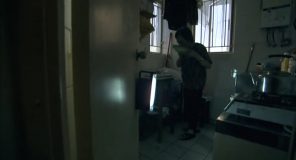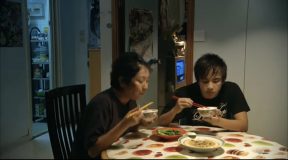THE WAY WE ARE, DIR. Ann Hui (2008)
Tin Shui Wai, Yuen Long District, Hong Kong
The Way We Are, directed by Ann Hui, introduced the daily life of the grass-root family Cheung as a secondary student living with his mother Guai in a public housing estate in Tin Shui Wai. Guai as a widow, worked in the supermarket while Cheung was waiting for the results of the exam. Their lives seem simple, but it is very fulfilling. An older woman, Leung, had just moved to Tin Shui Wai for a while and working in the same supermarket as Guai. With Guai’s enthusiasm and sincerity, Leung and Guai became familiar and took care of each other family-like. The story happened in Tin Shui Wai, which has been labeled as a city of sadness due to frequent domestic violence and poverty incidents. In addition to only focusing on sadness, Hui chooses to show the normal daily life in this area.
As this film mainly focused on Leung and Guai’s daily life, many scenes took place in their home. Leung lives alone in the public house estate. Most of the time, she needs to eat alone. There was a scene that described her daily routine of cooking. The photographer photographed her from outside the kitchen to inside. Leung only takes up a small part of the scene, with more than half of the frame being the door. Thus, the kitchen looks pretty small and narrow. As Leung’s lamp was broken, she had to use a table lamp instead. The contrast between light and dark is obvious. At the same location, this time Cheung and Guai came together to help Leung change the light bulb. Unlike the previous scenes, the interior of the kitchen is mainly filmed, and with the bright lighting, the whole kitchen can be seen. Since public housing is generally not very spacious, our impression of public housing is that it is full of clutter and very cramped. In fact, compared to this impression, Leung’s kitchen is not small, which even seems a little bit empty. Besides the scenes in the kitchen, scenes in dining tables also present different vibes. The atmosphere fostered from light and shooting angles, mainly emphasizing that she was cooking alone without any conversation with others and highlighting her loneliness.


Left: View Tin Shui Wai’s public housing estate. Scenes from The way we are 2008, directed by Ann Hui. Right: View Tin Shui Wai’s public housing estate. Scenes from The way we are 2008, directed by Ann Hui.
Besides, the scenes in Cheung and Guai’s dinner table also represent the different atmosphere. When shooting Cheung and Guai’s usual dinner, the main characters and the table for dinner only appear in the bottom right corner, while the entire screen, along with the table, looks empty. However, when they eat fruit together in the last scene, the whole screen is focused on the three people, and even the table is full of fruit. The contrast of the dinner tables represented the relationships between Cheung and Guai. At the usual dinner time, they seldom talk with each other and when they do, they usually talk about some trivial matters. The empty environment and quiet atmosphere vivid the estrangement. Meanwhile, in the last scene, Cheung became more understanding of Guai’s hard work and dedication and began to take the initiative to help Guai with household chores, leading to a more harmonious relationship between them. Moreover, the relationship between Guai and Leung is also like a family. The tight picture and the warm yellow lighting make the whole scene more heartwarming.


Left: View Tin Shui Wai’s public housing estate. Scenes from The way we are 2008, directed by Ann Hui. Right: View Tin Shui Wai’s public housing estate. Scenes from The way we are 2008, directed by Ann Hui.
All in all, the film uses different shooting angles and lighting in public housing estates to create an atmosphere and express other emotions in the same scenes.
— Cheung Tsz Ham, 3035779674
Notes:
1 Directed by Ann Hui at an estimated investment of HK$1 million and only shooting 15 days. The public houses used in the film are all rented houses, restoring the original environment of the tenants.
You have made detailed analyses of how the set appeared differently in different scenes and camera techniques, which is appreciated. You may utilize concepts from our reading ‘What Makes the Apartment Complex’ by Wojcik to further analyze how film provides another layer of understanding of space. On top of this, I wonder if you have done any virtual field trips to the estate? As it seems the images you displayed are all from the film. You may have other observations/findings if you compare the real spaces and their appearances in the film.